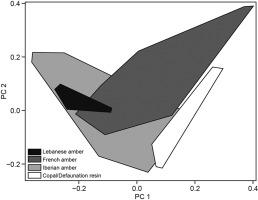Cretaceous Research ( IF 2.1 ) Pub Date : 2021-07-16 , DOI: 10.1016/j.cretres.2021.104958 Victoria E. McCoy 1 , H. Jonas Barthel 2 , Arnoud Boom 3 , Enrique Peñalver 4 , Xavier Delclòs 5 , Mónica M. Solórzano-Kraemer 6

|
Chemical analysis of amber, copal, and resin is a valuable tool for interpreting the botanic origin of amber and the ecological role of resin in ancient forests. Here we investigated for the first time the volatile and semi-volatile composition of Cretaceous amber, as well as copal and Defaunation resin produced by trees of the family Araucariaceae (Gymnospermae: Pinidae), via solid-phase microextraction gas chromatography-mass spectrometry. Principal component analysis (PCA) revealed a clear distinction between the Pleistocene copal/Defaunation resin and the much older Cretaceous amber samples. However, even among the younger resin samples whose plant producers were identified to the species level, the PCA did not clearly distinguish the groups, either at the species level or at the genus level. Therefore, even with ideal preservation of original chemistry, PCA of SPME GC/MS data will not differentiate varying botanic origins in the Cretaceous amber samples. There was extensive variation observed in the composition of the amber samples, but no separate groups in the PCA. This amber chemistry was most likely influenced by multiple factors, such as variable original resin chemistry and variable maturation as the most relevant. The Cretaceous amber deposits are proposed to represent forests with multiple taxa (even multiple families) of resin-producing trees, which varied over space and time, rather than representing a widespread and homogenous forest. As resin composition is strongly affected by both taxonomy of the resin-producing tree and ecological factors such as herbivory and pathogens, we propose that these forests were exposed to varying combinations of ecological factors.
中文翻译:

白垩纪琥珀的挥发性和半挥发性成分
琥珀、柯巴树脂和树脂的化学分析是解释琥珀植物起源和树脂在古代森林中的生态作用的宝贵工具。在这里,我们首次通过固相微萃取气相色谱 - 质谱法研究了白垩纪琥珀的挥发性和半挥发性成分,以及南洋杉科(裸子植物科:松科)树木产生的柯巴树脂和去区系树脂。主成分分析 (PCA) 揭示了更新世 copal/Defaunation 树脂与更古老的白垩纪琥珀样品之间的明显区别。然而,即使在植物生产者被确定为物种水平的年轻树脂样品中,PCA 也没有在物种水平或属水平上清楚地区分这些组。所以,即使对原始化学物质进行了理想的保存,SPME GC/MS 数据的 PCA 也不会区分白垩纪琥珀样品中不同的植物来源。在琥珀样品的组成中观察到了广泛的变化,但在 PCA 中没有单独的组。这种琥珀化学很可能受到多种因素的影响,例如可变的原始树脂化学和可变的成熟度是最相关的。白垩纪琥珀矿床被提议代表具有多个产树脂树类群(甚至多个科)的森林,它们随空间和时间而变化,而不是代表一个广泛且同质的森林。由于树脂成分受产树脂树的分类学和食草动物和病原体等生态因素的强烈影响,



























 京公网安备 11010802027423号
京公网安备 11010802027423号